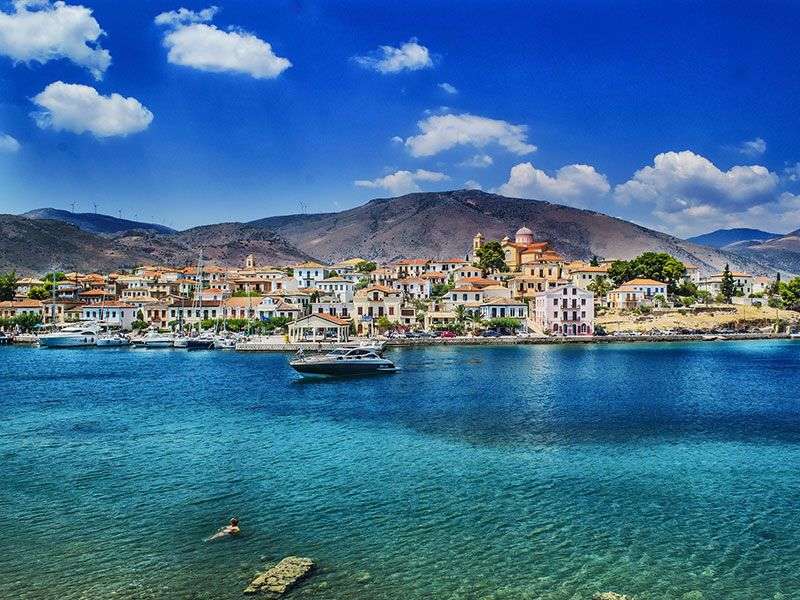The Aegean Sea, an arm of the Mediterranean, lies between the mainland of Greece and Turkey, dotted with over 1,400 islands and islets. This breathtaking stretch of water, with its shimmering turquoise hues and deep blue depths, has played a pivotal role in shaping ancient and modern civilization. Rich in history, culture, and natural beauty, the Aegean Sea attracts millions of visitors each year and remains a symbol of tranquility and exploration.
Stretching approximately 610 km (380 miles) north to south and about 300 km (186 miles) wide, the Aegean Sea connects to the Sea of Marmara and the Black Sea via the Dardanelles and Bosporus straits. The Cyclades, Dodecanese, North Aegean, and Sporades are just a few of the island groups that call the Aegean home, each offering unique landscapes, historical landmarks, and cultural experiences.
Historical Significance of the Aegean Sea
The Aegean Sea is often referred to as the cradle of Western civilization. It played a central role in the rise of the Minoan, Mycenaean, and later, the Classical Greek civilizations. It was across the Aegean that goods, ideas, and people moved freely, fostering trade, philosophy, science, and democratic ideas.
The Minoans and Mycenaeans
The Minoans, based on the island of Crete, were among the earliest advanced civilizations in Europe, flourishing between 2700–1450 BCE. Their sea-faring prowess made the Aegean a vibrant trade route. Later, the Mycenaeans, situated on the Greek mainland, inherited and expanded these maritime networks, further enriching Aegean culture.
The Classical Era and Beyond
During the Classical period, Athens and Sparta dominated the Aegean region. Naval supremacy became essential, especially during conflicts such as the Persian Wars and the Peloponnesian War. The sea enabled the rapid movement of troops and supplies, making it a vital military and economic artery.
In later centuries, the Byzantine Empire, Ottoman Empire, and Venetian merchants also contested control of the Aegean, understanding its strategic importance for commerce and politics.
Geography and Climate
Natural Features
The Aegean Sea’s underwater landscape features trenches, basins, volcanic formations, and seamounts. Some notable islands with volcanic origins include Santorini, part of the Cyclades, which has one of the world’s largest calderas.
The region is also prone to earthquakes, especially in areas where the African and Eurasian tectonic plates meet. Despite its geologic instability, this region is rich in biodiversity and marine life.
Climate
The Aegean Sea experiences a Mediterranean climate—hot, dry summers and mild, wet winters. Coastal and island destinations enjoy long summers that extend from May to October, attracting tourists seeking sun-drenched beaches and crystal-clear waters.
Famous Islands in the Aegean Sea
Each Aegean island offers a distinct experience. Here are some of the most well-known:
Santorini
Famed for its white-washed buildings, blue-domed churches, and dramatic cliffs, Santorini is a volcanic island that boasts some of the most romantic sunsets in the world. Visitors flock to Oia and Fira to experience its panoramic views and luxury resorts.
Mykonos
A paradise for party-goers and beach lovers, Mykonos is known for its vibrant nightlife, luxury hotels, and beautiful sandy beaches. However, it also has a quieter side, with traditional villages and historical sites like the Delos ruins nearby.
Rhodes
Located in the southeastern Aegean, Rhodes is one of the largest islands and famous for the Colossus of Rhodes, one of the Seven Wonders of the Ancient World. The Old Town of Rhodes is a UNESCO World Heritage site, showcasing medieval architecture and a rich cultural past.
Lesbos
Known for its olive groves and literary history (home of the ancient poet Sappho), Lesbos offers visitors hot springs, charming villages, and a laid-back atmosphere.
Naxos, Paros, and Tinos
These islands are part of the Cyclades and offer a more traditional Greek experience with fewer crowds. Naxos, the largest of the Cyclades, features lush landscapes, ancient temples, and sandy beaches.
Marine Biodiversity and Ecology
The Aegean Sea supports an impressive array of marine life, including dolphins, monk seals, sea turtles, and thousands of fish species. Coral reefs and underwater caves make it a top destination for scuba diving and snorkeling.
Efforts to preserve the Aegean’s ecology include:
- Marine Protected Areas (MPAs)
- Restrictions on overfishing and trawling
- Educational programs for sustainable tourism
The Archipelagos Institute of Marine Conservation, based on the island of Samos, conducts extensive research to protect this delicate ecosystem.
Economy and Tourism
Tourism Boom
Tourism is the backbone of the Aegean economy. Islands like Santorini, Mykonos, and Rhodes receive millions of tourists annually. Cruise ships, island-hopping ferries, boutique hotels, and all-inclusive resorts keep the local economy thriving.
Popular activities include:
- Yachting and sailing tours
- Archaeological tours to sites like Delos
- Hiking and nature exploration
- Wine tasting, especially on Santorini
- Traditional festivals showcasing local music, dance, and cuisine
Fishing and Agriculture
Fishing remains a vital industry in smaller communities, providing fresh seafood to local markets and restaurants. Many islands cultivate olives, grapes, figs, and herbs, contributing to Greece’s robust Mediterranean cuisine.
Real Estate and Investment
The picturesque beauty of the Aegean has also sparked interest in real estate, especially among foreign investors looking to buy vacation homes or open hospitality businesses. Properties with views of the sea, especially on Santorini and Mykonos, are among the most sought-after in Greece.
Aegean Cuisine
Aegean cuisine is a blend of Greek and Anatolian flavors. Fresh seafood, olive oil, wine, cheeses, and locally grown vegetables dominate the menu.
Popular dishes include:
- Grilled octopus
- Fava (split pea puree) from Santorini
- Kleftiko (slow-cooked lamb)
- Loukoumades (honey-soaked doughnuts)
- Greek yogurt with honey and walnuts
Wines from Santorini, especially Assyrtiko, are internationally acclaimed for their distinct volcanic minerality.
Transportation in the Aegean Sea
The sea acts as a major route for ferries, cargo ships, and cruise liners. The Greek Ferry Network connects Athens (Piraeus Port) to hundreds of islands, making island-hopping easy and affordable.
Airports
Major islands like Santorini, Mykonos, Rhodes, and Crete have international airports, welcoming travelers from all over Europe and beyond.
Ports and Marinas
Modern marinas, especially in tourist hubs, offer docking for private yachts and charter boats. The popularity of sailing trips and yacht charters is increasing, attracting high-end tourism.
Mythology and the Aegean Sea
The Aegean Sea is steeped in mythology. One of the most famous legends is that of King Aegeus, the sea’s namesake. According to myth, he mistakenly believed his son Theseus had died fighting the Minotaur in Crete. In despair, Aegeus threw himself into the sea—hence the name “Aegean.”
The sea also features in numerous tales involving Poseidon, Apollo, and Aphrodite, reflecting its deep connection to ancient Greek spirituality and storytelling.
Environmental Challenges
While the Aegean remains stunning, it faces environmental threats:
- Plastic pollution: Litter from tourism and shipping
- Overfishing: Impacting marine biodiversity
- Climate change: Affecting sea levels and marine ecosystems
- Oil spills and maritime accidents
Greece and international partners continue to develop policies to minimize environmental damage, such as EU-backed sustainability programs.
Golden Visas Greece
Greece offers a highly attractive Golden Visa Program, which allows non-EU nationals to obtain a residence permit by investing in real estate. The minimum investment requirement is €250,000, one of the lowest thresholds in Europe. Many investors choose properties in the Aegean region, particularly on sought-after islands like Santorini, Mykonos, or Paros, combining lifestyle with financial benefit. The program includes visa-free travel within the Schengen Zone and can lead to permanent residency or citizenship under certain conditions, making it an excellent option for international buyers seeking both mobility and Mediterranean living.
Aegean Sea in the Modern World
Today, the Aegean Sea remains vital for Greece’s economy, geopolitics, and cultural identity. It is a central point of tension between Greece and Turkey over territorial waters, Exclusive Economic Zones (EEZs), and oil exploration rights. Despite these disputes, the region is largely peaceful and welcoming to tourists.
The Greek government and local communities are investing in:
- Sustainable tourism
- Green energy initiatives (e.g., wind and solar farms on islands)
- Marine conservation
The Aegean Sea, thus, stands as a beacon of balance between nature, culture, and progress.
Conclusion
The Aegean Sea is more than just a body of water—it’s a vibrant ecosystem, a historical treasure, and a cultural icon. Its islands tell stories of gods and heroes, its waters connect past and present, and its shores invite travelers to explore timeless beauty. Whether you’re a tourist, historian, investor, or environmentalist, the Aegean holds something for everyone. Its enduring legacy continues to shape the identity of Greece, captivating hearts and minds across the globe.





